The tightening plaster is a bactericidal product with hypoallergenic properties, which is designed to tighten the edges of wounds, healing deep injuries skin, postoperative sutures.
These medical products are available in the form of adhesive strips that are firmly fixed to the skin surface, as well as in the form of liquid formulations. The adhesive patches are suitable for the treatment of patients with sensitive skin, children and persons prone to allergic reactions.
Record content:
- 1 Features of the use of tightening plasters for wounds, stitches, cuts
- 2 Types of plasters
- 3 Benefits of wound healing patches
- 4 Indications
- 5 Contraindications
-
6 Instructions for the use of tightening plasters
- 6.1 Rules for using a tightening patch for cuts and abrasions
- 6.2 Instructions for using the tightening patch on contaminated wounds
- 6.3 Application of a tightening patch on postoperative wounds
-
7 Popular brands of wound healing plasters, description, cost
- 7.1 Omnistrip
- 7.2 Tegaderm Pad
- 7.3 Askina barier
- 7.4 Steri strip
- 7.5 Oper tape paper
- 8 Wound Healing Videos
Features of the use of tightening plasters for wounds, stitches, cuts
A tightening plaster for wounds, which is used to treat stitches, injuries, deep cuts, has the following distinctive features:
- does not cause skin irritation during prolonged wear;
- the edges of the medical device have better fixing ability;
- during prolonged use, the bactericidal strip does not deform and does not slip;
- the local action of the biochemical components that make up the tightening patch is provided;
- a minimum amount of antibacterial and anti-inflammatory substances penetrates into the bloodstream, with which the gauze base of the patch is impregnated;
- while removing the bactericidal strip, there is no discomfort, pain and adhesion of tissue to open areas of the wound;
- tightening patches do not just protect the wound from environmental factors, but have a compressive effect, squeezing the edges of the wound surface for their faster healing.
The main feature of the use of tightening patches for wounds, stitches, cuts is the high efficiency, availability and safety of these funds. Germicidal strips are an indispensable part of first aid kits during outdoor activities, long trips, hiking, performing work with an increased danger.
Types of plasters
A compression wound patch is a medical product manufactured by pharmaceutical companies that has a specific purpose. The table below details the types of patches that are used depending on the nature of the injury, its extent and severity.
| Types of plasters | Application of tightening strips |
| Antibacterial | The constricting patches of this type contain silver ions or antibacterial agents that suppress the pathogenic activity of infectious microorganisms. They are prescribed for use in patients who have deep tissue damage with signs of acute or chronic inflammation of bacterial etiology. Plasters of this type perform a double function of tightening the edges of the wound due to the adhesive base, as well as antiseptic treatment. |
| Fixing | Fixing plasters are used for first aid to close the wound surface, prevention of profuse blood loss and the ingress of dirt particles, dust, infectious microorganisms. Products of this type are produced for children and adult patients, on a standard basis and with a waterproof coating. Due to constant pressure on the edges of the wound, the tissue fusion process occurs 2-3 times faster. |
| Wound healing | Tightening plasters with a wound healing effect are indicated for use in patients suffering from diabetic, purulent, infectious and inflammatory wounds, the healing of which occurs with complications, requires regular antiseptic treatment and application dressing material. |
| Postoperative | Postoperative patches with a fixing contraction effect are made of high-quality elastic material and are intended for application to moving parts of the body. The medical device prevents suture divergence, has a compressive effect, prevents the formation of diaper rash and the development of the inflammatory process. In the later stages of postoperative recovery, this type of patch can be used for faster resorption of sutures and epithelialization. |
| Liquid | This is a separate type of adhesive bandages that are liquid-based. The medicine is applied to the body surface by aerosol spraying. After hardening, a dense film forms on the top of the wound, which pulls together the damaged edges epithelial tissues, protects the wound from the penetration of pathogenic microorganisms, the ingress of dirt particles and dust. Liquid patches with a tightening effect contain rosin, perchlorovinyl or formaldehyde resin, acetone, chloroform, dimethylformamide, dibutyl phthalate, vegetable oils.
|
The type of tightening patch, which is indicated for use in the presence of an open wound, is determined by the attending surgeon, traumatologist or infectious disease specialist. An individual procedure for changing the bactericidal lining and the duration of wearing is established.
Benefits of wound healing patches
A tightening patch for the treatment of open wounds protects epithelial tissues from getting dust, dirt particles, viral, fungal and bacterial microorganisms, accelerate the regeneration process cells.
The advantages of using this type of germicidal strips are as follows:
- the tightening plaster is intended for long-term wearing and can be used after the planned treatment of the wound surface (the subsequent change of the dressing is carried out after 8-12 hours);
- the gauze fabric of the strips is impregnated with a hypoallergenic and adhesive composition, which includes antiseptic, anti-inflammatory and wound-healing components;
- tightening plasters are made of a material that has breathable properties, which prevents steaming of the skin, the formation of excess moisture and the beginning of the skin softening process;
- bactericidal strips are glued to the surface of the skin without the need for invasive therapy with incisions or punctures of epithelial tissues;
- timely closure of the wound with antiseptic and anti-inflammatory strips is the prevention of infection, the development of a purulent process, the formation of deep scars and scars;
- the ease of use of tightening patches does not require the involvement of specialists in the field of surgery, and also the use of medical instruments (staplers for fixing a wound, needles, suture material);
- replacement of bactericidal strips is carried out independently after preliminary treatment of the wound with antiseptic agents;
- depending on the width, depth, severity and nature of the wound surface, you can always use tightening plasters with a certain chemical composition, the size of the useful surface.
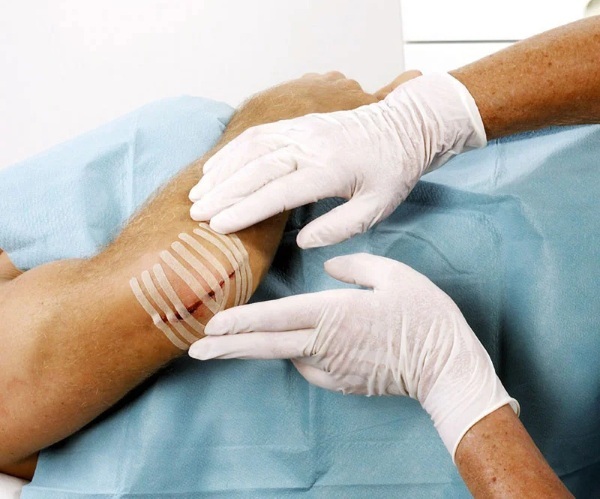
The main advantage of tightening patches is that they can be used in the first minutes after damage to the skin and soft tissues of the body. This is an element of first aid, which allows you to prevent profuse blood loss, the ingress of pathogenic microorganisms and foreign particles into the blood.
The composition of the bactericidal strips is selected individually, depending on the intended purpose of the product. Tightening plasters are made on the basis of herbal extracts, silver ions, emollient gels, antibacterial complexes, analgesics that suppress pain.
Indications
The tightening plaster for wounds is indicated for use in children, patients of the adult and elderly age group, which have the following types of damage to the skin surface of the body and deeper tissues:
- postoperative wounds that are at the healing stage, and the suture material requires additional fixation and compression compression;
- deep mechanical injuries of soft tissues resulting from falls, impacts, collisions with sharp objects (if inside wounds have got particles of dirt, dust, debris, then the tightening plaster is applied only after preliminary antiseptic treatment fabrics);
- skin cuts caused by careless handling of a knife, saw, abrasive materials;
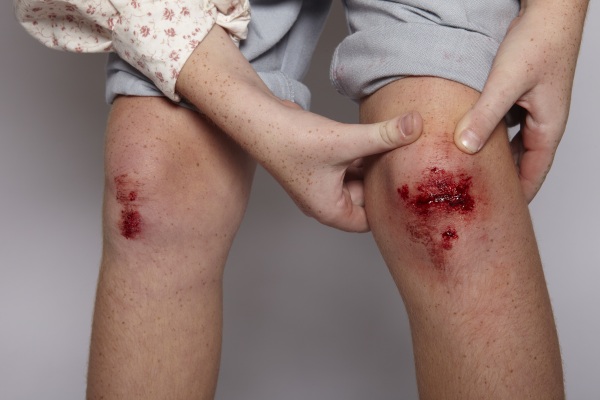
- burns of 1 and 2 degrees, which require additional exposure to antibacterial and wound-healing agents, as well as closure from the aggressive effects of environmental factors;
- wound surfaces of any etiology, the healing of which is complicated by infection of tissues with bacterial microorganisms (in this case a tightening plaster with a bactericidal effect promotes the evacuation of purulent contents, suppresses pathogenic microflora, relieves acute inflammation);
- diabetic damage to the tissues of the lower extremities, which have signs of a necrotic process, and their slower regeneration is associated with high blood glucose levels.
The tightening plaster for wounds is used for the complex treatment of skin lesions, the restoration of epithelial tissues and the fight against the inflammatory process of bacterial etiology. The use of a medical device must be agreed with the doctor.
Contraindications
A fixing plaster with a bactericidal or simply constricting effect is contraindicated for use in cases where if a person has the following diseases or pathological conditions of the body:
- individual intolerance to the components that make up the fixing strips of this type (expressed in manifestation of a local allergic reaction, accompanied by itching, redness of the skin, edema, the formation of small rash);
- the presence of deep wounds and injuries of the body, which have signs of a closed purulent abscess, requiring preliminary opening and sanitation with the help of surgical intervention;
- during the injury to the skin or soft tissues, particles of dirt, grass, leaves, chips of metal products, glass and other debris (such a wound must be washed and pre-cleaned, and then its surface is closed with the help of a tightening plaster);
- damage to arterial and venous vessels, the restoration of which requires a full-fledged surgical operation with the further imposition of suture material;
- fungal, infectious or viral skin diseases, the course of which is accompanied by the formation of open wounds and trophic ulcers (such pathological foci are not closed with a tightening plaster, but require a complex medication treatment).
The appointment of the tightening strips is carried out by the attending physician based on the results of the patient's diagnostic examination. Depending on the patient's state of health, the doctor may decide that it is inappropriate to use an adhesive or liquid patch with a fixing effect.
Instructions for the use of tightening plasters
The order of fixing the band-aids depends on the type of wound surface and the nature of the injury. Particular care is required to apply strips to areas of the body that have been subjected to surgery using suture material.
Rules for using a tightening patch for cuts and abrasions
Applying fixation strips after skin damage due to a cut with sharp objects, the following rules are observed:
- Wash hands thoroughly using warm water, laundry or toilet soap.
- Move the edges of the wound and make sure that no dirt or other foreign particles get on the exposed tissue.
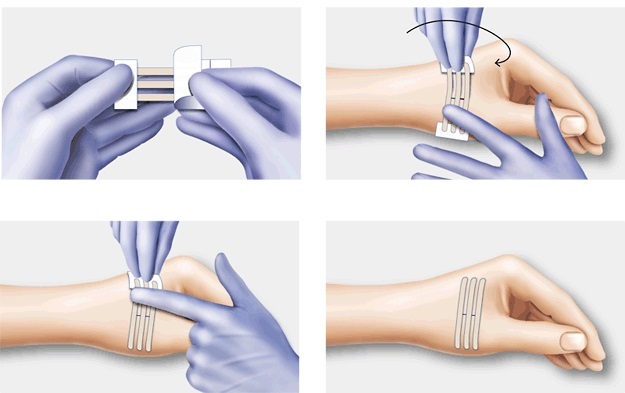
- Get the patch out of the individual packaging.
- Tear off the protective backing of the strip that releases the adhesive part of the medical device.
- Do not touch with your fingers the part of the patch that should be fixed on the damaged part of the body.
- Apply a tightening plaster to the wound so that the surface of the medical device, which is saturated with herbal extracts, anti-inflammatory, healing and antiseptic agents, adhered to damaged tissues, and the adhesive base was fixed on dry and healthy parts of the epithelium.
If a band-aid was applied in the course of first aid, it is necessary to seek the advice of a surgeon or traumatologist. The fixing strips are changed every 8 hours.
Instructions for using the tightening patch on contaminated wounds
Damage to the skin, with dirt and other foreign particles entering the wound, closed with a fixing plaster in compliance with the following rules of the instruction:
- Wash hands thoroughly with soap and warm water.
- Rinse an open wound with hydrogen peroxide to remove contamination.
- Print the adhesive tape ready for installation.
- Apply the impregnated part of the medical device to the wound surface, and attach the adhesive segment to clean and dry skin.
After sanitizing damaged tissues, a person should be monitored by a traumatologist or surgeon. Precautions are taken to prevent bacterial inflammation of the wound.
Application of a tightening patch on postoperative wounds
Fixation of bactericidal strips on the surface of the postoperative wound is carried out in compliance with all of the above rules. Antiseptic treatment of the area of the body, on which the suture material is applied, is performed only by medical professionals.
After unsealing the patch, it is fixed on the wound surface. The drug-impregnated part of the medical device is applied to the junction segment of the dissected tissue. The adhesive part of the strip is attached to dry and healthy skin, but as far as possible from the seams. To do this, use a large patch.
Popular brands of wound healing plasters, description, cost
The most popular are bactericidal, anti-inflammatory and wound-healing strips, which are distinguished by high therapeutic efficacy and material availability.
Omnistrip
Omnistrip is a hypoallergenic adhesive patch indicated for use in postoperative wounds. The medical device is applied to the surface of the suture material to improve compression and accelerate tissue regeneration.
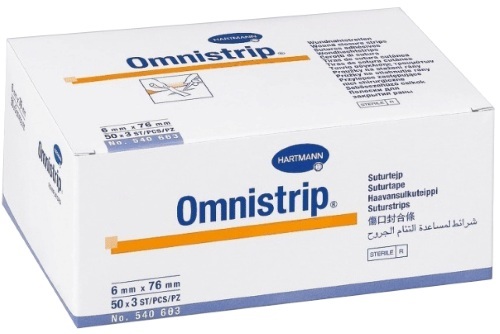
The average cost of 1 patch is 110 rubles. Packaged in a cardboard box containing 50 medical devices. The tightening strips are manufactured by the German company Hartmann.
Tegaderm Pad
Tegaderm Pad is an antiseptic and wound healing patch with a tightening effect. The edges of the medical device are treated with a special glue that holds it to the surface of the body.
In the center of the strip there is a gauze pad, which is impregnated with medicinal solutions of antiseptic and anti-inflammatory action. The patch is produced in the USA, Germany and Poland. The average cost of a product is 90 rubles. for a strip measuring 10x12 cm.
Askina barier
Askina Barier is a liquid tightening patch that is sprayed into an open wound in an even layer. Within 20-30 sec. the aerosol of the drug dries completely, forming a dense transparent film.
The liquid patch tightens the epithelial tissue and protects the wound from negative environmental factors. The Askina Barier liquid patch is produced by the German company Brown, and its average cost is 970 rubles. per bottle with a capacity of 28 ml.
Steri strip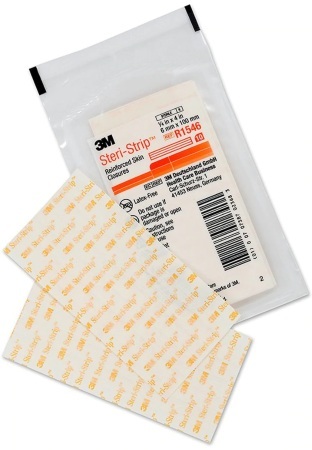
Steri Strip is a versatile tightening patch that is used to close cuts, incisions, incisions and lacerations.
The medical device consists of a woven base, which is located in the center, can be impregnated with antiseptic components, as well as adhesive edges.
The patch is produced by the American pharmaceutical company ZM. The average cost of the product is 115 rubles. for 1 pc.
Oper tape paper
Oper tape paper is a hypoallergenic tightening strip that is used to close open wounds. In surgical practice, this medical device is actively used for the purpose of faster postoperative tissue restoration.
Oper tape paper consists of a woven and cellulose base, which prevents irritation of the skin surface even when the patch is worn for a long time. The adhesive patch is manufactured by the Spanish company Iberhospitex. The average cost of fixation strips is 120 rubles. for 1 pc.
The tightening patch for closing open wounds is an effective remedy that is indicated for use by patients of all age groups. Fixation strips are used to join cuts, lacerations, soft tissue dissections, and prevent suture divergence in the postoperative period.
The tightening patch provides not only a compressive effect on the tissue, but also creates a barrier protection of open wounds from the effects of bacterial, viral, fungal microorganisms, dirt and dust. Fixation strips promote faster regeneration of the epithelium, have anti-inflammatory and antiseptic properties.
Wound Healing Videos
Surgeon about wound healing:


